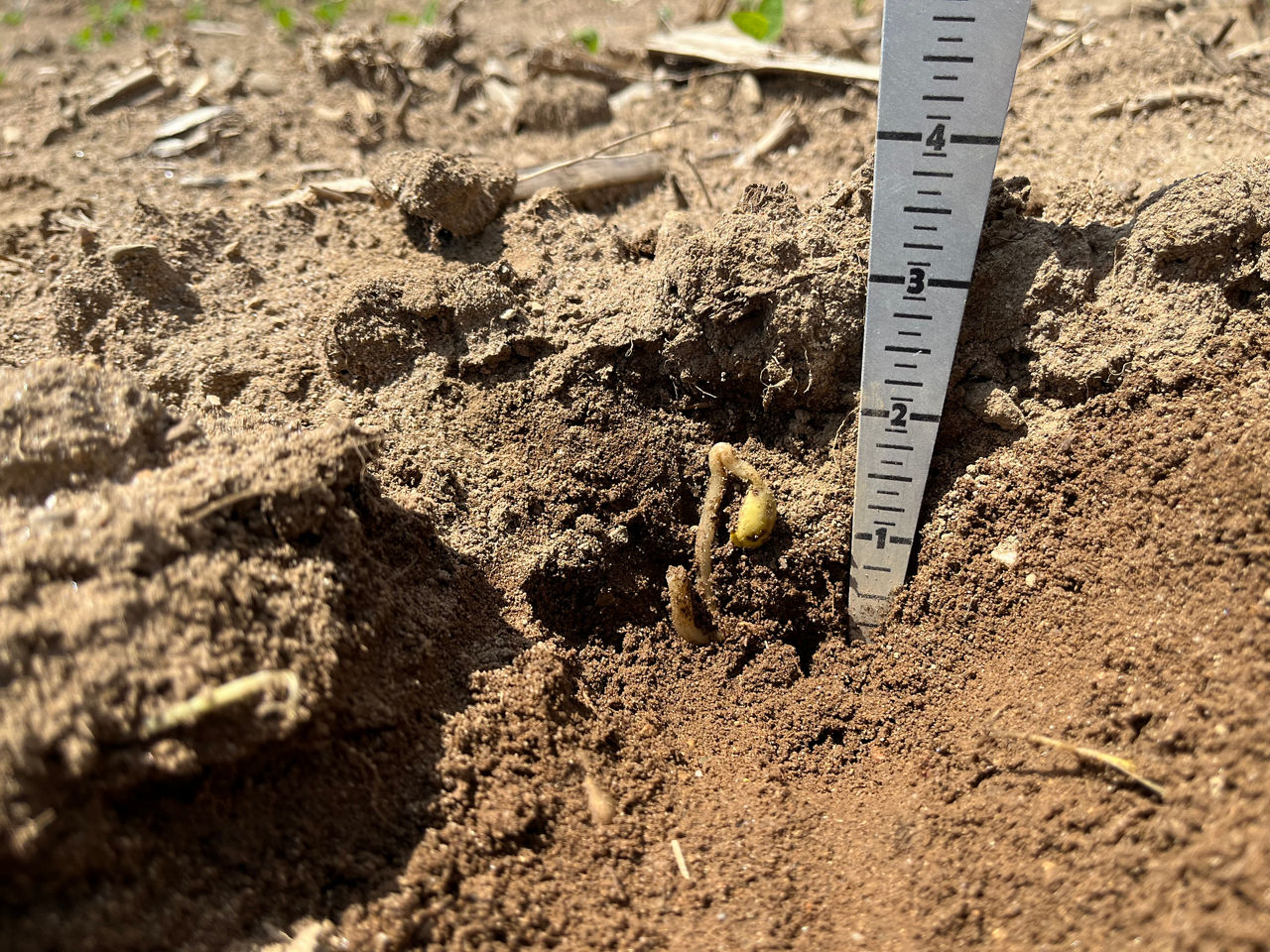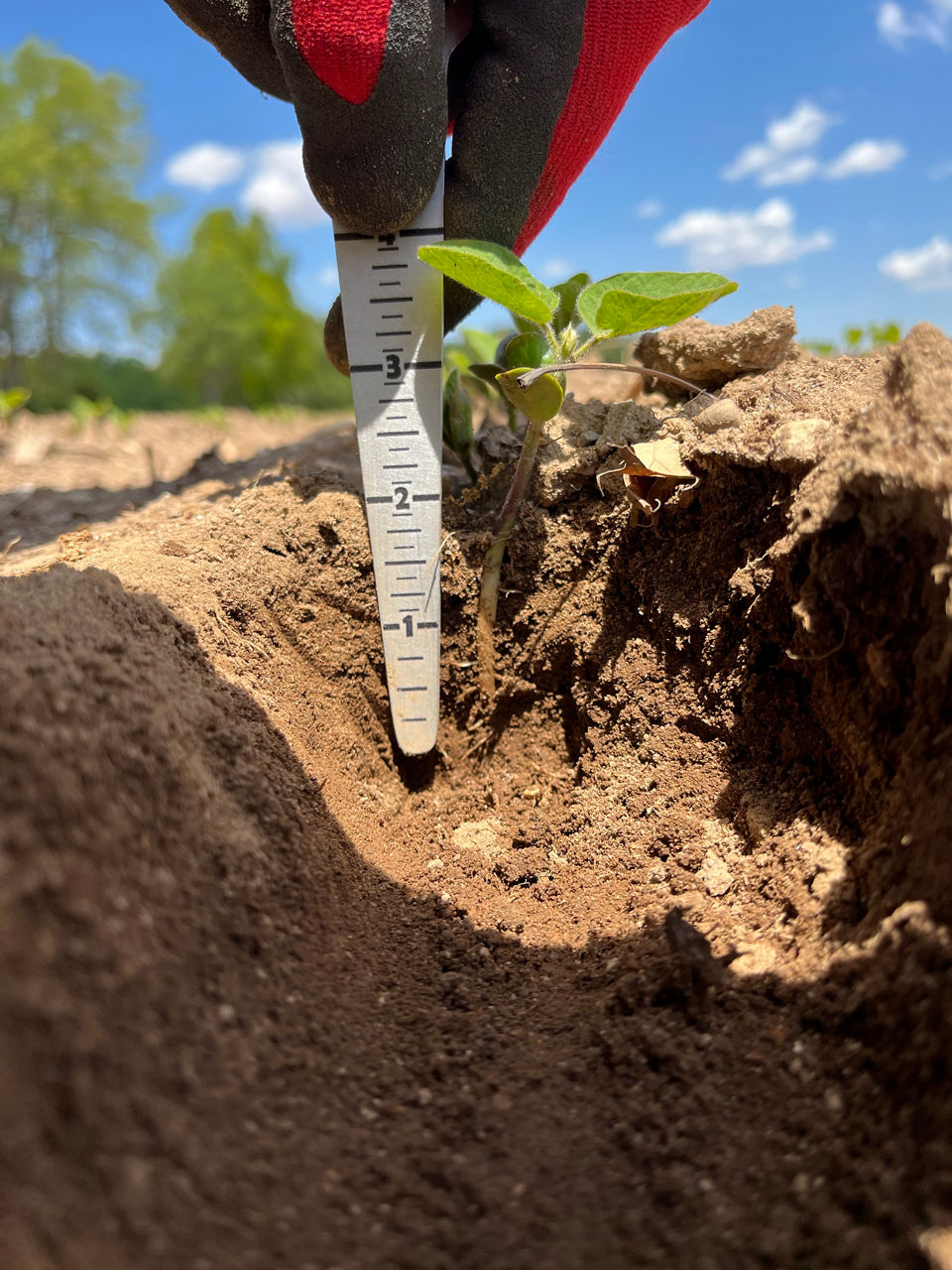Soybean Seeding Depth to Help Minimize Early Season Stress
November 1, 2024
Soybean seeding depth and soil contact are critical for seedling development and early season vigor. General guidelines for soybean planting depth have been 1 to1.5 inches.1,2,3 There are many variables that can influence your decision on what depth to plant and this may change as field and environmental conditions change. Depth adjustments should be made at the beginning of the season and checked when field conditions change or switching to a new field. Measuring hypocotyl length (base of green stem from soil line to beginning of radical root) can be done late into the growing season to help determine the planting depth of each seed. Frequent soil digs and proper adjustments can help provide for better emergence and root development.
Equipment
When considering planting depth, it is important to understand your equipment capabilities and restrictions. Box drills and air seeders offer narrower row spacing that provide great early season canopy that can assist with weed control.2 Uniform depth has improved in modern drills over the “controlled spill” of older models. However, consistent seed placement is still superior with 15- to 30-inch row type planters being the most common.1,2 Active air or hydraulic down pressure and other precision technologies on planters help to achieve more consistent depth control across rolling terrain, crop residues, and other variations in soil conditions.2 For increased efficiency planters, air seeders, and drills have an increased width of application and seed storage. These improvements add considerable weight leading to row compaction especially on loose/wet soil. Consult your equipment manufacturer’s manual to best understand your equipment and how to properly calibrate or adjust depth.
Environmental Conditions
Overall shallower planting should be considered when planting early season into cool moist soils, or fine textured soils that are prone to crusting.2 Deeper planting may be warranted on course soils, dry conditions, or late planting.2 Current and future environmental conditions should influence your planting depth decisions. Never plant if field conditions are too wet, as this can cause compaction within the seed trench and result in inadequate root establishment and emergence. Soybean seedlings generally emerge within a week after planting when soil temperatures are above 70 °F and adequate moisture is present.5 When soil temperatures are between 50 to 60 °F emergence can be greater than 15 days.5
The soil surface (above 1 inch) or drier soil is more prone to daily temperature swings from the sun’s thermal rays, while deeper (below 1.5 inch) or moist soil is more stable.5 Delays in emergence should be longer with the increased depth and can result in increased onset of disease or feeding from pests like seedcorn maggot or slugs.2,5 Use of seed treatments offer increased protection from pathogens and pests during this period but are not fail safe under extremely delayed emergence. Another concern with slow germination/emergence in cool wet soils is herbicide injury from PPO herbicides.4
Early Plant in Frost Climates
Growers in climates prone to early season frost have increased planting depth in hopes of delaying emergence until the risk of frost has decreased. The seeds in Figures 1 and 2 were planted the same day in the same course textured soil field and with conventional tillage. The target depth was two inches to delay emergence until the risk of frost had decreased. Unfortunately, soil moisture varied within the field causing the planter to sink deeper in spots. Emergence in these areas was delayed over three weeks with inconsistent stands. The seedling in Figure 1, seed depth over two inches with increased row compaction, has a damaged hypocotyl and likely would not survive. The seedling in Figure 2 was a healthy plant at unifoliate growth stage (VC) at a seed depth of two inches and in an area of the field with more consistent stands. Caution should be used when planting soybean seeds in periods of increased risk of frost regardless of seeding depth.


Dry Conditions
A common guideline for planting soybean seed is placing the seed 0.5 inch into consistent soil moisture.2 There may be large variations in soil moisture across changes in soil type, crop residue, or tillage depth. Soybean seed can be planted 2.5 inches deep when adequate moisture is not available to germinate uniformly at shallower depths.1 Deep planting on heavy soils prone to crusting creates a risk that the seedlings may exhaust energy supply or break the hypocotyl before pushing through the soil surface.1 Wider row spacing such as 30 inch rows planted at uniform depth can help create more “pushing power” as there are more seeds per foot of row.1,3 Caution should still be used when planting and heavy rain is expected before the seedlings emerge.
In extreme cases when soil moisture is not available deeper than two inches, stale planting or shallow planting at a minimum of 0.75 inch can be considered.1 This can result in delayed emergence until adequate rainfall, generally 0.5 inch for most soil types occurs.1 Soybean seed imbibes over 50% of its weight in water to begin the germination process.1,5 Once seed begins imbibing water it becomes sensitive to dry conditions before the radical root has established into adequate moisture.1 Seeds that are planted too shallow may die from moisture loss which results in reduced stands.3
Seed Characteristics
Seed size should also be considered when determining your target for seeding depth. Larger seeds contain larger energy reserves; therefore, they can generally emerge from greater depths compared to smaller seeds.2 Large seeds also have larger cotyledons; therefore, caution should be used when deep planting large seeds on finer textured soils as it is more challenging for the cotyledons to pull up through the soil crust.2 If planting deeper than 1.5 inches, work with your seed dealer or agronomist to understand the emergence score and early season vigor of your soybean products.
Summary
In summary, plant soybean seeds 0.5 inch into moisture for the most consistent emergence between overall depths of 1 to 1.5 inches. Planting depths 1.75 to 2 inches are being evaluated by industry and academia to increase soybean yield potential compared to current depth guidlines.5,6 Before experimenting with deeper planting, consider the risks to your system. Understanding your equipment, current/future environmental conditions, and seed product characteristics may help you to optimize your soybean planting depth decisions. Often, when scouting fields with stand reductions, planting depth is a factor along with other factors such as wet planting, cold soils, inadequate row closure, or soil crusting. Regularly checking depth through digging is the only way to know for sure that you are placing the seed in optimal conditions. This also allows for the checking of seed to soil contact and row compaction.
Channel Agronomist
John Craft
Sources
1Anderson, E. (original by Staton, M.) 2023. Soybean planting depth considerations when planting into dry soil conditions. Michigan State University Extension. https://www.canr.msu.edu/news/soybean-planting-depth-considerations-when-planting-into-dry-soil-conditions
2Anderson, E. (original by Staton, M.) 2016. Soybean planting depth matters. Michigan State University Extension. https://www.canr.msu.edu/news/soybean_planting_depth_matters
3Anderson, M. and Licht, M. 2021. Soybean seed depth in dry conditions. Integrated Crop Management. Iowa State University Extension and Outreach. https://crops.extension.iastate.edu/blog/mark-licht-meaghan-anderson/soybean-seed-depth-dry-conditions
4Rees, J., Jhala, A., and Jackson-Ziems, T. 2020. Q & A: What is causing problems with soybean emergence? CROPWATCH. University of Nebraska-Lincoln. https://cropwatch.unl.edu/2020/q-what-causing-problems-soybean-emergence
5Rees, J. and Specht, J. 2020. Understanding the soybean germination process for early planted soybean decisions. CROPWATCH. University of Nebraska-Lincoln. https://cropwatch.unl.edu/2020/understanding-soybean-germination-process-early-planted-soybean-decisions
6Specht, J., Rees, J., Glewen, K., and Grassini, P. 2014. Soybean planting depth: Consider planting deeper. CROPWATCH. University of Nebraska-Lincoln. https://cropwatch.unl.edu/soybean-planting-depth-consider-planting-deeper
Web sources verified 9/18/24. 1110_452201
You may also like...
Here are some articles that may also be of interest to you